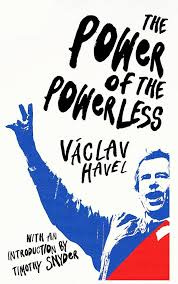On Normalization as a Source of Power
Insights from Scott, Havel, Mill, and Tocqueville
Today’s essay is about “normalization,” a concept that appears repeatedly (though sometimes called differently) in many different contexts in social sciences and political discussions. An approximative definition is a social process through which individuals increasingly conform to a set of norms and patterns, making their behavior more predictable and uniform. That makes normalization a very ambivalent phenomenon from a normative point of view.
On the one hand, some degree of normalization is required to make social life possible at all. Social institutions such as language or legal rules are at the same time instruments and symptoms of normalization. The fact that we speak the same language (and that this is commonly known) makes my behavior predictable in the sense that, for instance, if I suddenly shout “attention!” (in French) people know that there is an immediate danger and that I’m likely to act in accordance. More generally, sharing social rules facilitates coordination and creates the possibility of socially beneficial but individually costly forms of cooperation in so-called social dilemmas. The very existence of shared social rules indicates that our behaviors belong to the same “form of life” and are similar, if not identical, in some respects.
On the other hand, normalization also undermines diversity. This can be problematic in at least two respects. First, normalization tends to constrain social experimentation and innovation, in so far as they are a source of unpredictability and even instability. The main danger is that this increases the risk that society is trapped in a bad equilibrium, i.e., a set of social rules and practices that have adverse consequences on individual and social welfare or promote an unfair state of affairs. If society is organized such that individuals have no reasonable choice but to conform to the norms, bad practices will solidify and be virtually impossible to displace. Cristina Bicchieri’s account of this kind of adverse social norms illustrates well how normalization can make social change difficult to trigger because social experimentation is perceived as a threat to the community.[1] Second, because normalization tends to severely reduce the ecological diversity of practices and behavior, it makes the entire society more vulnerable to changes in its environment and to the realization of various risks. Normalization contributes for instance to the uniformization of dietary habits, which can be catastrophic if these habits have adverse health effects.
Another significant aspect of uniformization may be less obvious. Some weeks ago, I discussed coercion as an instrument of power. Normalization can sometimes work in tandem with coercion, though it may also be an instrument of power in its own rights. Consider for instance James Scott’s insightful analysis of states’ attempts at social planning.[2] Scott argues that what lies behind such attempts is something similar to what I call normalization. Scott more specifically emphasizes the role of standardization (of language, of measurements, of facts) as a tool of social control. Standardization is a precondition for the state to gather the kind of information needed to enforce particular social rules and, ultimately, to make people behave in a certain way – with or without the effective use of coercion. Standardization is part of a more global project that Scott calls “high modernism” and that refers to “the aspiration to the administrative ordering of nature and society.”[3] According to Scott, high modernism transcends ideologies and intellectual domains, being displayed for instance in architecture (Le Corbusier is one of James’s most prominent examples), agriculture and forestry, and politics. At the roots of high modernism is the rationalist belief that social change can be implemented top-down thanks to scientific and technical knowledge. However, effective social planning requires an upstream preparation. Social complexity and diversity are the enemy of social planning. Before remodeling society, you need to simplify it by making the behavior of individuals less diverse and more predictable. You start by redesigning cities so that you can more easily control flux. You standardize the language. You gather standardized information about persons, goods, and activities. This is the first step of an unlimited rationalist ambition:
“The scope of intervention was potentially endless. Society became an object that the state might manage and transform with a view toward perfecting it. A progressive nation-state would set about engineering its society according to the most advanced technical standards of the new moral sciences. The existing social order, which had been more or less taken by earlier states as given, reproducing itself under the watchful eyes of the state, was for the first time the subject of active management. It was possible to conceive of an artificial, engineered society designed, not by custom and historical accident, but according to conscious, rational, scientific criteria. Every nook and cranny of the social order might be improved upon: personal hygiene, diet, child rearing, housing, posture, recreation, family structure, and, most infamously, the genetic inheritance of the population.”[4]
Normalization is therefore at the same time a precondition and an achievement of social planning. It is a precondition because you need standardized information to act by design in society. Since this design operates from a reduced set of principles and is based on standardized information, it can only reinforce the normalization of society. The high modernist ideal (utopian or dystopian depending on one’s view) is that of a fully normalized society where everybody predictively behaves per rationally designed rules and patterns, making social control easier in case a change of rules should be implemented.
In Scott’s account, normalization is not necessarily authoritarian or totalitarian – many instances of social planning through normalization come from “progressist” social thinkers and politicians. In his insightful analysis of power in “post-totalitarian” societies, Vaclav Havel shows the key role of normalization.[5] Havel’s discussion starts with an imaginary shopkeeper who displays in front of his store the slogan “Workers of the World, Unite!” Havel suggests that the only reason why he does that is because “it has been done that way for years, because everyone does it, and because that it is the way it has to be.”[6] In other words, he does it because it is normal. Of course, this normality hides a lot of social pressure and coercive threats. But paradoxically, Havel argues that post totalitarian societies – contrary to classical dictatorships – generally do not need to exert coercion to maintain social obedience. In post totalitarian society, power does not even come from the top but rather from the fact that individuals publicly endorse an ideology that normalizes behavior and social relations. Crucially, this doesn’t mean that individuals need to really believe in the truth of the ideology. Individuals may, as Havel says, “live within a lie.” Normalization may only be behavioral, but that is enough to guarantee the stability of the power structure because nobody can assert with certainty that others are living within a lie.[7] An important implication of normalization in Havel’s analysis is that it ultimately leads to the suppression of individuality. By accepting to live within a lie and to “self-normalize,” individuals renounce everything that makes them unique, and distinct from others, and to pursue what matters in their view. This is the essence of post-totalitarian power: not coercion, but the destruction of individuality by complete normalization.
We might be tempted to believe that normalization solely comes from the state. There is no doubt that the state of the most important source of normalization. Regions of the world where a state has been existing for centuries display a higher degree of normalization than regions where states are relatively young. Because its power is tributary to its capacity to sustain a minimal degree of normalization in the population it is ruling on, the long-term existence of the state tends to bring linguistic, administrative, cultural, and social homogeneity. However, normalization can also be the result of more spontaneous social forces. The “tyranny of custom” that John Stuart Mill analyzes in On Liberty is a particularly aggressive instance of normalization.[8] Indeed, in Mill’s essay the main instance of the normalization is not the state – something interesting from the liberal point of view – but the social pressures for conformity that the majority exerts on the individual will. Mill’s analysis shares an interesting aspect with Havel’s account of post totalitarian societies. For Mill as for Havel, conformity triggers the risk of destroying individuality. Of course, the kind of societies Mill and Havel are interested in are fairly different. Mill is concerned by the normalization displayed within emerging democratic societies where freedom is progressively consecrated as a primary value. The nature of the phenomenon essentially remains the same, however:
“Protection, therefore, against the tyranny of the magistrate is not enough: there needs protection also against the tyranny of the prevailing opinion and feeling; against the tendency of society to impose, by other means than civil penalties, its own ideas and practices as rules of conduct on those who dissent from them; to fetter the development, and, if possible, prevent the formation, of any individuality not in harmony with its ways, and compel all characters to fashion themselves upon the model of its own.”[9]
Alexis de Tocqueville is maybe an even more lucid analyst of the risk of spontaneous normalization in a democratic context. Tocqueville famously argues in the second volume of Democracy in America that the “passion for equality” that characterizes the democratic form of life is likely to backfire on the stability of democratic institutions. Similarly to Mill, Tocqueville sees that the pressure for normalization coming from social opinion is a potential recipe for the tyranny of the majority. Left on its own, the endless thirst for equality may destroy individuality, causing people to retreat into their private sphere and feel alien to public affairs. The last stage of democratic normalization is what Tocqueville calls “individualism” and that he uses as a synonymous for “egoism.”
“As social equality spreads, a greater number of individuals are no longer rich or powerful enough to exercise great influence upon the fate of their fellows, but have acquired or have preserved sufficient understanding and wealth to be able to satisfy their own needs. Such people owe nothing to anyone and, as it were, expect nothing from anyone. They are used to considering themselves in isolation and quite willingly imagine their destiny as entirely in their own ends.”[10]
Freedom is then put in jeopardy because democratic normalization creates space for would-be leaders to seize power.[11] All this does not mean that normalization is an enemy of freedom, not more than a free society would be a society without power relations. Normalization is also a condition for freedom – a completely non-normalized world would rather look like an Hobbesian nightmare. As identified by Scott, Havel, Mill, and Tocqueville, normalization is however a source of political and social power that left unguarded, is a source of tyranny.
[1] Cristina Bicchieri, Norms in the Wild: How to Diagnose, Measure, and Change Social Norms (Oxford University Press, 2016).
[2] James C. Scott, Seeing Like a State: How Certain Schemes to Improve the Human Condition Have Failed (New Haven, CT London: Yale University Press, 1999).
[3] Ibid., p. 88.
[4] Ibid., p. 92.
[5] Vaclav Havel, The Power of the Powerless (Vintage Classics, 1978 [2018]).
[6] Ibid., p. 14.
[7] A more social scientific account would point out the role of “pluralistic ignorance” and “preference falsification” here. See for instance Timur Kuran, Private Truths, Public Lies: The Social Consequences of Preference Falsification, Reprint edition (Cambridge, Mass.: Harvard University Press, 1997).
[8] John Stuart Mill, On Liberty, Utilitarianism and Other Essays, ed. Mark Philp and Frederick Rosen, Second edition (Oxford: Oxford University Press, 2015).
[9] Ibid., p. 8.
[10] Alexis de Tocqueville, Democracy in America and Two Essays on America, ed. Isaac Kramnick, trans. Gerald Bevan (London: Penguin Classics, 2003), p. 589.
[11] There is also a striking convergence between Havel’s analysis of post totalitarian power and Tocqueville’s analysis of democracy. Havel argues that post totalitarian power is also grounded on the kind of normalization triggered by the “consumer society,” rendering individuals politically passive in a similar way as described by Tocqueville. I leave this topic here for a future post.





